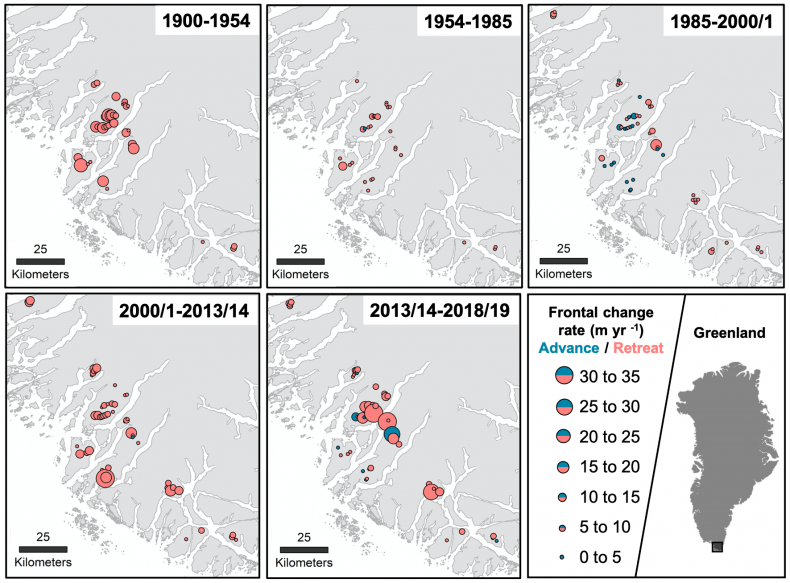The author(s) will give a talk
Changes in South Greenland’s peripheral glaciers since the Little Ice Age
1 Northwestern University
2 Northwestern University
3 University of Copenhagen
4 University of Wisconsin Madison
Glaciers and ice caps peripheral to the Greenland Ice Sheet have contributed substantially to sea-level rise this century [1]. However, multi-decadal, quantitative measurements of their fluctuations remain rare, especially prior to the satellite era. This limitation hinders our understanding of glacier response to atmospheric climate variability, and in particular to sustained warming as anticipated for the future. Here, we investigate fluctuations in South Greenland’s mountain glaciers since the Little Ice Age (LIA), a cold period between ~1250 and 1900 C.E. when most glaciers across Greenland reached their historical maximum extents [2]. We map changes in the position of 62 glacier fronts over the past ~120 years using a combination of 20th century historical aerial photographs and modern satellite imagery. To extend our record to the beginning of the 20th century, we also use a high resolution orthophotograph [3] to map the positions of moraines and trimlines—geomorphic evidence that mark the glacier’s historical maximum extent. In addition, we use two recently developed geospatial tools [4,5] to model LIA glacier surfaces and their equilibrium-line altitudes (ELAs) for an additional ~50 glaciers to investigate the magnitude of the LIA summer temperature depression relative to present.
Preliminary results suggest that South Greenland’s peripheral glaciers have responded synchronously with changes in air temperature over the past ~120 years. We find the highest rates of retreat post LIA deglaciation in the early-to-mid 20th century: -9.5 ± 5.4 m yr-1 between ~1900 and 1954 C.E. In the mid-to-late 20th century, retreat slowed, and frontal change rates averaged -3.2 ± 0.6 m yr-1 between 1954 and 1985 C.E., and -1.6 ± 2.1 m yr-1 between 1985 and 2000/1 C.E. At the turn of the 21st century, the rate of retreat more than quadrupled from the previous time interval and averaged -7.3 ± 3.3 m yr-1 between 2000/1 and 2013/14 C.E. Retreat rates remained relatively high in the most recent time interval, averaging -5.6 ± 6.3 m yr-1 between 2013/14 and 2018/19 C.E. In comparison to similar glacier length change studies in other regions of Greenland [6-8], glaciers in the south followed the same overall trends but differed in the magnitude of change. Of particular interest, South Greenland’s glaciers showed the lowest rate of retreat in the 21st century. Regional comparisons also show that glacier retreat has accelerated since (roughly) the turn of the 21st century across Greenland, which suggests a largely homogenous response to increased air temperatures. Finally, results of the LIA paleoglacier modeling show an average ELA lowering of ~90 ± 45 m, suggesting that summer air temperatures were ~0.7-0.9°C cooler than present during the coldest period of the LIA, assuming no change in precipitation.
Overall, this work extends the observational record from an understudied region of Greenland and provides pre-satellite era observations of glacier extents during a time period when quantitative measurements are rare. The work also places recent retreat into a ~100+ year perspective and will help to improve understanding of glacier sensitivity to atmospheric climate variability.
Bolch, T., et al. "Mass loss of Greenland's glaciers and ice caps 2003–2008 revealed from ICESat laser altimetry data." Geophysical Research Letters 40.5 (2013): 875-881.
Kelly, Meredith A., and Thomas V. Lowell. "Fluctuations of local glaciers in Greenland during latest Pleistocene and Holocene time." Quaternary Science Reviews 28.21-22 (2009): 2088-2106.
Korsgaard, N. J., et al. "Digital elevation model and orthophotographs of Greenland based on aerial photographs from 1978–1987." Scientific Data 3.1 (2016): 1-15.
Pellitero, R., et al. "GlaRe, a GIS tool to reconstruct the 3D surface of palaeoglaciers." Computers & Geosciences 94 (2016): 77-85.
Pellitero, R., et al. "A GIS tool for automatic calculation of glacier equilibrium-line altitudes." Computers & Geosciences82 (2015): 55-62.
Bjørk, A. A., et al. "Changes in Greenland’s peripheral glaciers linked to the North Atlantic Oscillation." Nature Climate Change 8.1 (2018): 48-52.
Bjørk, A. A., et al. "An aerial view of 80 years of climate-related glacier fluctuations in southeast Greenland." Nature Geoscience 5.6 (2012): 427-432.
Leclercq, P. W., et al. "Brief communication" Historical glacier length changes in West Greenland"." The Cryosphere 6.6 (2012): 1339-1343.

Fig 1.
Frontal change rates for 62 glaciers in South Greenland over five observational periods between ~1900-2019 C.E.